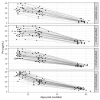Progesterone Concentrations during Canine Pregnancy
- PMID: 34944146
- PMCID: PMC8697939
- DOI: 10.3390/ani11123369
Progesterone Concentrations during Canine Pregnancy
Abstract
Pregnancy and lactation are amongst the most challenging times of a bitch's life. Most studies focusing on the endocrinological aspect of pregnancy consider only a small number of animals. The aim of this study was to evaluate progesterone (P4) concentrations in a large number of bitches during early, mid and late pregnancy. In total, 126 bitches of various breeds were recruited following a thorough clinical and gynecological examination during estrus. Blood samples were collected three times (T1-T3) during pregnancy or from non-pregnant dogs in diestrus, and P4 was measured via chemiluminescence. At T1 (11-19 days post-ovulation (dpo)), serum P4 concentrations were 30.23 ± 6.65 ng/mL and 28.45 ± 6.26 ng/mL, at T2 (23-32 dpo) they were 22.73 ± 6.27 ng/mL and 22.59 ± 5.77 ng/mL and at T3 (52-60 dpo) they were 6.68 ± 2.18 ng/mL and 3.17 ± 2.26 ng/mL, in pregnant (n = 98) and non-pregnant (n = 23) dogs respectively. The P4 concentrations differed significantly between pregnant and non-pregnant animals at the last examination (p ≤ 0.001). In the context of hypoluteoidism, the gathered data yielded interesting results. Overall, 28 out of 98 pregnant bitches showed a greater decline (>15 ng/mL) in P4 concentrations from early to mid-pregnancy, and 56 bitches showed P4 concentrations lower than deemed adequate (>20 ng/mL at T1 and T2, >5 ng/mL at T3) according to existing recommendations. Despite not being supplemented with P4, none of those animals suffered from abortion or preterm delivery. Considering that supplementation of P4 can entail considerable risks for the bitch and the puppies, more research on P4 concentration patterns, diagnosis of hypoluteoidism and treatment indications and options is indicated.
Keywords: dog; gestation length; hypoluteoidism; litter size; parturition; pregnancy; progesterone.
Conflict of interest statement
Author Müller, Elisabeth is the CEO, author Weber, Corinna was employed by the company Laboklin. The remaining authors declare that the research was conducted in the absence of any commercial or financial relationships that could be construed as a potential conflict of interest.
Figures



References
LinkOut - more resources
Full Text Sources

